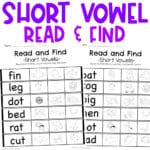How to teach kids short vowel sounds? Teaching kids short vowel sounds can be engaging and effective with a variety of methods. you can create a well-rounded and engaging learning experience that supports children in mastering short vowel sounds effectively. Adapt the activities to suit the interests and learning styles of the children you’re working with, and celebrate their progress along the way. Here’s a step-by-step guide:

Introduce the Concept
Begin by explaining what short vowel sounds are. You can say something like, “Short vowels make a quick sound and are often found in three-letter words.”
Use Mnemonics and Visualizations
Introduce mnemonics or visualizations to help children remember the short vowel sounds. For example, you could associate each vowel sound with a memorable image or a simple phrase. “A” can be associated with an apple, “E” with an egg, “I” with an igloo, “O” with an octopus, and “U” with an umbrella. These visual cues can aid in retention and recall.
Use Visual Aids
Visual aids such as flashcards, posters, or illustrations can help kids associate the vowel sounds with their corresponding letters. Make sure the vowels are clearly highlighted.
Interactive Whiteboard Activities
If you have access to interactive whiteboards or tablets, utilize them to create interactive short vowel sound activities. There are numerous educational apps and online resources that offer interactive games, quizzes, and lessons focused on phonics and vowel sounds. Children can actively participate by dragging and matching letters, recording their voices, and completing interactive exercises.
Word Building Games
Introduce word building games where children manipulate letter cards or tiles to create short vowel words. You can provide them with a set of consonant cards and vowel cards and challenge them to build as many short vowel words as they can within a time limit. This hands-on approach reinforces phonemic awareness and spelling skills.
Word Sorting Activities
Create word sorting activities where children categorize words based on their vowel sounds. For example, provide a list of words and ask children to sort them into groups of words with short vowel sounds and words with long vowel sounds.
Syllable Segmentation
Break down words into syllables and focus on the vowel sounds in each syllable. This helps children understand how vowel sounds can change depending on their position in a word. For instance, in the word “rabbit,” the short vowel sound occurs in the first syllable, while the second syllable contains a different vowel sound.
Story Dictation
Engage children in story dictation activities where they dictate short stories containing words with short vowel sounds, and you write them down. Afterward, read the stories aloud together, emphasizing the short vowel sounds as you go. This activity not only reinforces short vowel sound recognition but also encourages storytelling skills and creativity.

Word Building Games
Introduce word building games where children manipulate letter cards or tiles to create short vowel words. You can provide them with a set of consonant cards and vowel cards and challenge them to build as many short vowel words as they can within a time limit. This hands-on approach reinforces phonemic awareness and spelling skills.
Word Hunts
Conduct word hunts where children search for short vowel words in books, magazines, or environmental print. Provide them with a list of short vowel words to find, or challenge them to identify short vowel words independently. This activity encourages active reading and reinforces the connection between spoken and written language.
Interactive Online Resources
Utilize interactive online resources and educational websites that offer games, videos, and activities specifically designed to teach short vowel sounds. These resources can provide additional practice and reinforcement in a format that children find engaging and enjoyable. I highly recommend ABCMouse (aff link) to help with teaching short vowel sounds.
Crossword Puzzles and Word Searches
Create crossword puzzles or word searches featuring short vowel words for children to solve. These puzzles not only reinforce short vowel sound recognition but also help develop vocabulary and spelling skills. You can customize the puzzles based on children’s proficiency levels and areas of focus.
Word Sorts by Patterns
Extend word sorting activities by focusing on specific short vowel word patterns, such as CVC (consonant-vowel-consonant) words or words with similar spelling patterns but different vowel sounds. Encourage children to identify and categorize words based on these patterns, deepening their understanding of phonics principles.
Repetition and Practice
Practice is key to mastering short vowel sounds. Provide plenty of opportunities for children to hear, say, and identify short vowel sounds in words. You can use word games, worksheets, or online resources for this purpose.
Phonemic Awareness Activities
Engage children in activities that focus on phonemic awareness, such as sound matching games or rhyming exercises. This helps them develop an ear for distinguishing between different vowel sounds.
Word Families
Introduce word families that contain words with short vowel sounds, such as the “-at” family (cat, hat, mat) or the “-en” family (pen, ten, hen). This helps children recognize patterns and generalize their understanding of short vowel sounds.

Integration with Writing Activities
Integrate short vowel sound learning with writing activities by having children write sentences or short stories containing words with short vowel sounds. Encourage them to use their knowledge of short vowel sounds to spell words correctly and convey meaning effectively.
Multisensory Approaches
Incorporate multisensory activities to appeal to different learning styles. For example, you can have children trace the letters of short vowel words while saying the sounds out loud or use manipulatives like letter tiles to build short vowel words.
Reading Aloud
Read aloud to children and point out words with short vowel sounds as you encounter them in books. Encourage children to read along and identify the short vowel sounds in the words they see.
Feedback and Encouragement
Provide positive reinforcement and feedback as children practice short vowel sounds. Celebrate their successes and offer gentle corrections when needed.
Interactive Games and Apps
Utilize educational games and apps designed to teach phonics and short vowel sounds in a fun and interactive way. Many of these resources provide instant feedback and reinforcement, which can be highly motivating for children.
Real-life Application
Encourage children to apply their knowledge of short vowel sounds in everyday situations, such as when they’re reading signs, labels, or simple sentences.
Assessment and Progress Tracking
Regularly assess children’s understanding of short vowel sounds to track their progress. This can be done through informal observations, quizzes, or games. Use the results to identify areas that may need additional reinforcement or support.
By implementing these additional strategies, you can create a dynamic and effective learning environment that supports children in mastering short vowel sounds. Tailor your approach to suit the needs and preferences of the children you’re teaching, and don’t hesitate to experiment with different methods to find what works best for them. This is the best approach when you want to know how to teach kids short vowel sounds.







